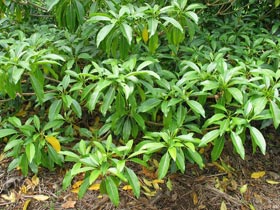Rauvolfia sandwicensis
Genus
Rauvolfia
Species
sandwicensis
Hawaiian Names with Diacritics
- Hao
Hawaiian Names
- Hao
Synonyms
- Excavatia sandwicensis
- Ochrosia sandwicensis
- Rauvolfia degeneri
- Rauvolfia forbesii
- Rauvolfia helleri
- Rauvolfia mauiensis
- Rauvolfia molokaiensis
- Rauvolfia remotiflora
Did You Know…?
The wood of hao is very hard. Kaluna M. Kaʻaiakamanu, a pastor, notes: "It is called Hao because of what it is like due to the hardness that can spoil an adze." Interestingly, the name for iron in Hawaiian is hao.
Distribution Status
Endemic
Endangered Species Status
No Status
Plant Form / Growth Habit
- Shrub
- Tree
Mature Size, Height (in feet)
- Shrub, Tall, Greater than 10
- Tree, Small, 15 to 30
Life Span
Long lived (Greater than 5 years)
Landscape Uses
- Accent
- Provides Shade
- Screening
Additional Landscape Use Information
An excellent and showy xeric, or drought tolerant, tall shrub or tree requiring watering only in the driest months.
Source of Fragrance
- Flowers
Additional Fragrance Information
The tiny flowers of hao have a fragrance similar to plumeria, which belong to the same family. [Rick Barboza, Hui Kū Maoli Ola]
Plant Produces Flowers
Yes
Flower Type
Not Showy
Flower Colors
- Greenish-White
Additional Flower Color Information
The tiny whitish flowers are clustered at branch tips.
Blooming Period
- Spring
- Fall
- Winter
Plant texture
- Coarse
Leaf Colors
- Light Green
- Medium Green
Additional Leaf Color Information
The glossy light-colored green leaves with a mid vein are clustered at branch tips.
Additional Pest & Disease Information
The milky sap of hao often deters leaf eating insects, but it may become infested with scale insects introduced by ants.
Fertilizer
An application of a balanced slow release fertilize with minor elements every six months is especially helpful for young saplings. Foliar feed monthly with kelp or fish emulsion, or a water-soluble fertilizer with a dilution of one half to one third of recommended strength. [David Eickhoff, Native Plants Hawaiʻi]
Pruning Information
Not necessary except to maintain the height or width. Best left as a free forming plant.
Water Requirements
- Dry
Additional Water Information
When well established water once a month. If hao is over watered the leaves become flaccid and limp.
Soil must be well drained
Yes
Light Conditions
- Full sun
- Partial sun
Additional Lighting Information
Hao grows best in sunny but filtered light.
Tolerances
- Drought
Soils
- Clay
- Organic
Limitations
Keep weeds minimal around hao as they can weaken plants.
Natural Range
- Niʻihau
- Kauaʻi
- Oʻahu
- Molokaʻi
- Lānaʻi
- Maui
- Hawaiʻi
Natural Zones (Elevation in feet, Rainfall in inches)
- 150 to 1000, 0 to 50 (Dry)
- 150 to 1000, 50 to 100 (Mesic)
- 150 to 1000, Greater than 100 (Wet)
- 1000 to 1999, 0 to 50 (Dry)
- 1000 to 1999, 50 to 100 (Mesic)
- 1000 to 1999, Greater than 100 (Wet)
- 2000 to 2999, 0 to 50 (Dry)
- 2000 to 2999, 50 to 100 (Mesic)
- 2000 to 2999, Greater than 100 (Wet)
Additional Habitat Information
The habitat primarily includes ridges, slopes, and gulches in mesic forests, but also scattered in relatively low elevation, open, remnant dry forests or dry shrublands from about 330 to over 2,600 feet. Hao can be seen on lava flows on Maui and Hawaiʻi.
![]() Special Features and Information
Special Features and Information
General Information
Hao (Rauvolfia sandwicensis) is in the Dogbane family or Apocynaceae which hosts other native members such as four species of hōlei (Ochrosia spp.), two species of kaulu (Pteralyxia spp.) and maile (Alyxia stellata).
The flowers of hao, though much smaller, resemble hōlei (Ochrosia spp.). Taxonomists actually called it by the name Ochrosia sandwicensis, which is now a former Latin name for hao.
Etymology
The genus Rauvolfia is named for Leonhard Rauwolf (ca. 1540-1596), a German physician, botanist and traveler in the Near East.
The species name sandwicensis refers to the "Sandwich Islands," as the Hawaiian Islands were once called, and named by James Cook on one of his voyages in the 1770's. James Cook named the islands after John Montagu (The fourth Earl of Sandwich) for supporting Cook's voyages.
Hawaiian Name:
Hao is also the name for iron in Hawaiian.
Early Hawaiian Use
The wood of hao is very hard. Kaʻaiakamanu notes: "It is called Hao because of what it is like due to the hardness that can spoil an adze." [1]
Medicinal:
The bark was scraped and mixed with its flowers in water. The medicine was drunk to aid in curing pāʻaoʻao (a childhood disease with physical weakening) and ʻea (thrush). [1]
Religion:
Though the smoke from hao is said to be poisonous, it is often found at heiau and perhaps was used for some religious purposes. Roots are also said to contain a certain amount of a poisonous substance. [3]
Additional References
[1] "Native Hawaiian Medicine--Volume III" by The Rev. Kaluna M. Kaʻaiakamanu, page 48.
[2] http://www.wehewehe.org [Accessed 8/13/10]
[3] "Hawaiian Natural History, and Evolution" by Alan C. Ziegler, pages 198.
PHOTOS FOR THIS SPECIES CAN BE SEEN AT THE LINK (Copy & Paste to your browser):
https://www.flickr.com/search/?user_id=50823119%40N08&sort=date-taken-desc&view_all=1&text=Rauvolfia%20sandwicensis
Plant Gallery
Back to Plant List
Other Nursery Profiles for Rauvolfia sandwicensis



